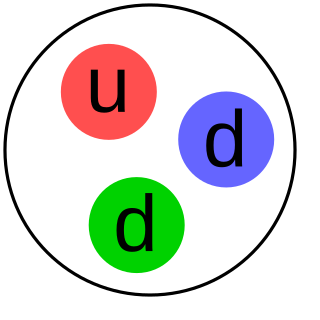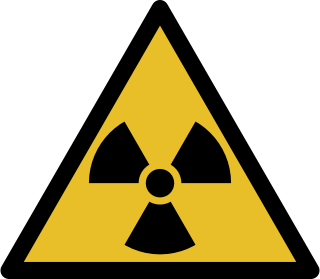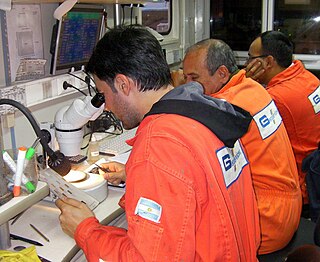
The neutron is a subatomic particle, symbol
n
or
n0
, with no net electric charge and a mass slightly greater than that of a proton. Protons and neutrons constitute the nuclei of atoms. Since protons and neutrons behave similarly within the nucleus, and each has a mass of approximately one atomic mass unit, they are both referred to as nucleons. Their properties and interactions are described by nuclear physics.

Neutron activation analysis (NAA) is the nuclear process used for determining the concentrations of elements in a vast amount of materials. NAA allows discrete sampling of elements as it disregards the chemical form of a sample, and focuses solely on its nucleus. The method is based on neutron activation and therefore requires a source of neutrons. The sample is bombarded with neutrons, causing the elements to form radioactive isotopes. The radioactive emissions and radioactive decay paths for each element are well known. Using this information, it is possible to study spectra of the emissions of the radioactive sample, and determine the concentrations of the elements within it. A particular advantage of this technique is that it does not destroy the sample, and thus has been used for analysis of works of art and historical artifacts. NAA can also be used to determine the activity of a radioactive sample.

Ionizing radiation is radiation, traveling as a particle or electromagnetic wave, that carries sufficient energy to detach electrons from atoms or molecules, thereby ionizing an atom or a molecule. Ionizing radiation is made up of energetic subatomic particles, ions or atoms moving at high speeds, and electromagnetic waves on the high-energy end of the electromagnetic spectrum.
In petroleum exploration and development, formation evaluation is used to determine the ability of a borehole to produce petroleum. Essentially, it is the process of "recognizing a commercial well when you drill one".

In the oil and gas industry, the term wireline usually refers to the use of multi-conductor, single conductor or slickline cable, or "wireline", as a conveyance for the acquisition of subsurface petrophysical and geophysical data and the delivery of well construction services such as pipe recovery, perforating, plug setting and well cleaning and fishing. The subsurface geophysical and petrophysical information results in the description and analysis of subsurface geology, reservoir properties and production characteristics.

Neutron radiation is a form of ionizing radiation that presents as free neutrons. Typical phenomena are nuclear fission or nuclear fusion causing the release of free neutrons, which then react with nuclei of other atoms to form new isotopes—which, in turn, may trigger further neutron radiation. Free neutrons are unstable, decaying into a proton, an electron, plus an anti-electron-neutrino with a mean lifetime of 887 seconds.
Well logging, also known as borehole logging is the practice of making a detailed record of the geologic formations penetrated by a borehole. The log may be based either on visual inspection of samples brought to the surface or on physical measurements made by instruments lowered into the hole. Some types of geophysical well logs can be done during any phase of a well's history: drilling, completing, producing, or abandoning. Well logging is performed in boreholes drilled for the oil and gas, groundwater, mineral and geothermal exploration, as well as part of environmental and geotechnical studies.

Neutron detection is the effective detection of neutrons entering a well-positioned detector. There are two key aspects to effective neutron detection: hardware and software. Detection hardware refers to the kind of neutron detector used and to the electronics used in the detection setup. Further, the hardware setup also defines key experimental parameters, such as source-detector distance, solid angle and detector shielding. Detection software consists of analysis tools that perform tasks such as graphical analysis to measure the number and energies of neutrons striking the detector.
Logging while drilling (LWD) is a technique of conveying well logging tools into the well borehole downhole as part of the bottom hole assembly (BHA).

Mud logging is the creation of a detailed record of a borehole by examining the cuttings of rock brought to the surface by the circulating drilling medium. Mud logging is usually performed by a third-party mud logging company. This provides well owners and producers with information about the lithology and fluid content of the borehole while drilling. Historically it is the earliest type of well log. Under some circumstances compressed air is employed as a circulating fluid, rather than mud. Although most commonly used in petroleum exploration, mud logging is also sometimes used when drilling water wells and in other mineral exploration, where drilling fluid is the circulating medium used to lift cuttings out of the hole. In hydrocarbon exploration, hydrocarbon surface gas detectors record the level of natural gas brought up in the mud. A mobile laboratory is situated by the mud logging company near the drilling rig or on deck of an offshore drilling rig, or on a drill ship.
Geosteering is the optimal placement of a wellbore based on the results of realtime downhole geological and geophysical logging measurements rather than three-dimensional targets in space. The objective is usually to keep a directional wellbore within a hydrocarbon pay zone defined in terms of its resistivity, density or even biostratigraphy. In mature areas, geosteering may be used to keep a wellbore in a particular section of a reservoir to minimize gas or water breakthrough and maximize economic production from the well. In the process of drilling a borehole, geosteering is the act of adjusting the borehole position on the fly to reach one or more geological targets. These changes are based on geological information gathered while drilling. Originally only a projected target would be aimed for with crude directional tools. Now the advent of rotary steerable tools and an ever-increasing arsenal of geophysical tools enables well placement with ever-increasing accuracy. Typically a basic tool configuration will have directional and inclination sensors, along with a gamma ray tool. Other options are neutron density, look ahead seismic, downhole pressure readings et al. Due to the vast volume of data generated, especially by imaging tools, the data transmitted to surface is a carefully selected fraction of what is available. Data is collected in memory for a data dump when back on surface with the tool.
Petrophysics is the study of physical and chemical rock properties and their interactions with fluids.
Spontaneous potential log, commonly called the self potential log or SP log, is a passive measurement taken by oil industry well loggers to characterise rock formation properties. The log works by measuring small electric potentials between depths with in the borehole and a grounded electrode at the surface. Conductive bore hole fluids are necessary to create a SP response, so the SP log cannot be used in nonconductive drilling muds or air filled holes.
Gas porosity is the fraction of a rock or sediment filled with a gas.
Sonic logging is a well logging tool that provides a formation’s interval transit time, designated as , which is a measure of a formation’s capacity to transmit seismic waves. Geologically, this capacity varies with lithology and rock textures, most notably decreasing with an increasing effective porosity. This means that a sonic log can be used to calculate the porosity of a formation if the seismic velocity of the rock matrix, , and pore fluid, , are known, which is very useful for hydrocarbon exploration.
Density logging is a well logging tool that can provide a continuous record of a formation's bulk density along the length of a borehole. In geology, bulk density is a function of the density of the minerals forming a rock and the fluid enclosed in the pore spaces. This is one of three well logging tools that are commonly used to calculate porosity, the other two being sonic logging and neutron porosity logging
The formation evaluation gamma ray log is a record of the variation with depth of the natural radioactivity of earth materials in a wellbore. Measurement of natural emission of gamma rays in oil and gas wells are useful because shales and sandstones typically have different gamma ray levels. Shales and clays are responsible for most natural radioactivity, so gamma ray log often is a good indicator of such rocks. In addition, the log is also used for correlation between wells, for depth correlation between open and cased holes, and for depth correlation between logging runs.

A nuclear density gauge is a tool used in civil construction and the petroleum industry, as well as for mining and archaeology purposes. It consists of a radiation source that emits a cloud of particles and a sensor that counts the received particles that are either reflected by the test material or pass through it. By calculating the percentage of particles that return to the sensor, the gauge can be calibrated to measure the density and inner structure of the test material.
A nuclear densometer is a field instrument used in geotechnical engineering to determine the density of a compacted material. Also known as a soil density gauge, the device uses the interaction of gamma radiation with matter to measure density, either through direct transmission or the "backscatter" method. The device determines the density of material by counting the number of photons emitted by a radioactive source (cesium-137) that are read by the detector tubes in the gauge base. A 60-second time interval is typically used for the counting period.
The Fine-Resolution Epithermal Neutron Detector (FREND) is a neutron detector that is part of the instrument payload on board the Trace Gas Orbiter (TGO), launched to Mars in March 2016. This instrument is currently mapping hydrogen levels to a maximum depth of 1 m beneath the Martian surface, thus revealing shallow water ice distribution.This instrument has an improved resolution of 7.5 times over the one Russia contributed to NASA's 2001 Mars Odyssey orbiter.






